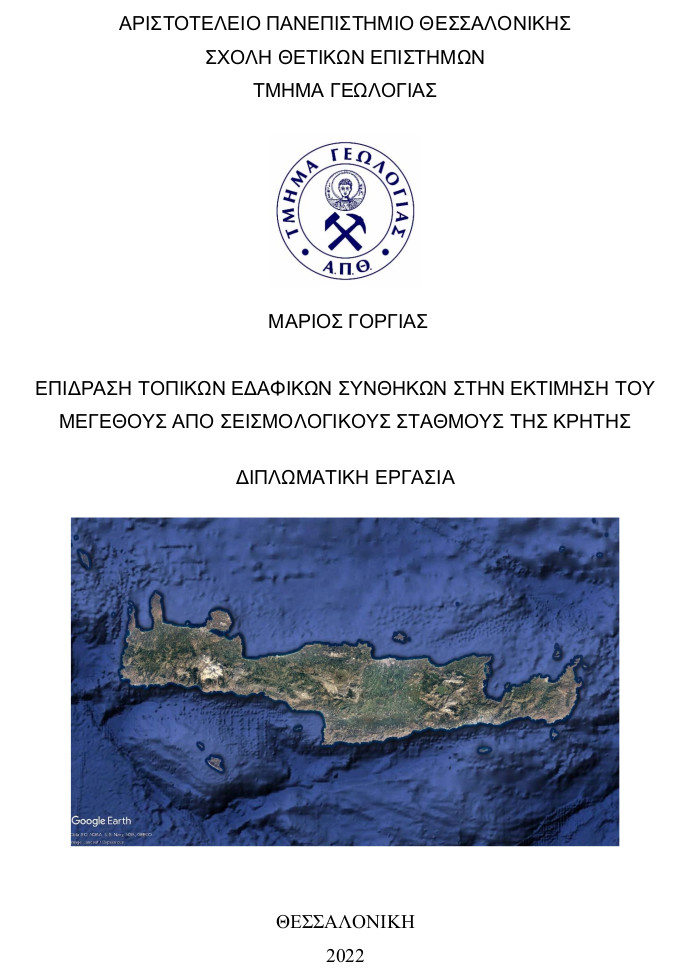
Επίδραση τοπικών εδαφικών συνθηκών στην εκτίμηση του μεγέθους από σεισμολογικούς σταθμούς της Κρήτης = Influence of site effects on magnitude estimation based on records of seismological stations in the island of Crete, Greece.
Περίληψη
Η εργασία αυτή ασχολείται με την εκτίμηση της επίδρασης των τοπικών εδαφικών συνθηκών στην εκτίμηση μεγέθους ML, από σεισμολογικούς σταθμούς εγκατεστημένους στην περιοχή της Κρήτης, κάνοντας χρήση καταγραφών εδαφικού θορύβου .
Η ανάγκη αυτή προέκυψε καθώς κατά τη χρήση των καταγραφών των σταθμών αυτών έχουν παρατηρηθεί, όπως θα φανεί και στη συνέχεια, κάποιες υπέρ- ή υπό-εκτιμήσεις μεγεθών. Για την επίτευξη αυτού του στόχου, ως αρχικά δεδομένα χρησιμοποιήθηκαν καταγραφές σταθμών της Κρήτης που ανήκουν στο δίκτυο σεισμογράφων του Εθνικού Αστεροσκοπείου Αθηνών (HL) αλλά και του σεισμολογικού δικτύου της Κρήτης (HC).
Η τεχνική που χρησιμοποιήθηκε είναι αυτή του φασματικού λόγου της οριζόντιας προς την κατακόρυφη συνιστώσα εδαφικού θορύβου και εφαρμόστηκε σε ημερήσια και εποχικά δείγματα 14 σεισμολογικών σταθμών .
Τέλος τα αποτελέσματα της μελέτης συσχετίσθηκαν με τις γεωλογικές συνθήκες που επικρατούν στην περιοχή που βρίσκεται ο κάθε σταθμός.
The accurate calculation of reliable local magnitude is a necessary condition for the compilation of earthquake catalogs that will be suitable and usable for studies of seismicity, seismic hazard, etc.
This work deals with the estimation of the influence of local site effects on the estimation of local magnitude ML, making use of ambient noise recordings from stations located on the island of Crete.
This need arose as during the use of the recordings of these stations there have been observed, as it will be seen later, some pro- or sub-estimates of magnitudes. To achieve this goal, recordings of stations in Crete belonging to the seismograph network of the National Observatory of Athens (HL) and the seismological network of Crete (HC) were used.
The method used is the HVSR method (Horizontal to Vertical Spectral Ratio) and was applied to diurnal and seasonal samples of 14 seismological stations.
Finally, the results of the study were correlated with the geological conditions prevailing in the area where each station is located.
Πλήρες Κείμενο:
PDFΑναφορές
Caputo R., Catalano S., Monaco C., Romagnoli G., Tortorici G and Tortorici L. Active faulting on the island of Crete (Greece). Geophys. J. Int., 183, 111-126, 2010.
McKenzie, D.P. Active tectonics of the Mediterranean region. Geophys. J.R. astr. Soc., 30, 109-185, 1972.
Papazachos, B.C., and Comninakis, P.E. Geophysical and tectonic features of the Aegean arc, J. Geophys. Res., 76, 8517-8533, 1971.
Παπαζάχος, Β. και Κ. Παπαζάχου. Οι Σεισμοί της Ελλάδας. «Εκδόσεις ΖΗΤΗ», 286 σελ., 2003.
Papazachos, C.B., Seismological and GPS evidence for the Aegean – Anatolia interaction. Geophys. Res. Lett. 26, 2653 – 2656, 1999.
Ritesma, A.R. The earthquake mechanism of the Balkan region. R. Netherl. Meteorol. Inst. Sci. Rep., 74, 1-36, 1974.
Scordilis, Ε.Μ., D. Kementzetzidou, B.C. Papazachos, Local magnitude calibration of the Hellenic Unified Seismic Network. J. Seismol. (2016), 20:319-332, 2015.
Εισερχόμενη Αναφορά
- Δεν υπάρχουν προς το παρόν εισερχόμενες αναφορές.
